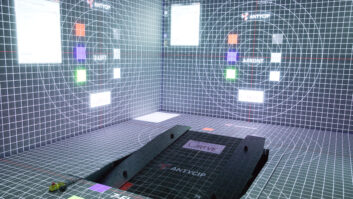
Today’s businesses are under increasing pressure to increase productivity and improve work efficiency across an increasingly dispersed workforce spread across multiple office locations around the world. This has a profound impact on work culture, technology in the workplace and office design. Maintaining productivity across such increasingly dispersed teams will require more effective collaboration tools and well-equipped meeting rooms to enable fast and easy collaboration between remote workers. These tools include easy, simple to use conferencing devices with high-quality video and audio.
These types of tools are already being used in meeting spaces, both in large conference rooms and small huddle rooms, by many organisations, but the next step for effective video conferencing involves a greater use of artificial intelligence. In fact, according to a recent study from Frost & Sullivan, artificial intelligence (AI) will play an important role in the future of video conferencing, by creating applications that deliver more natural, contextual and relevant meeting experiences.
I see three key ways in which AI is, and will likely continue to drive innovation, improve user experience and automate tasks in video conferencing and workplace communication.
- Computer Vision
One key area of innovation in video conferencing is computer vision. This technology can, for example, frame meeting participants and then automatically zoom on the speaker to deliver a better video experience for those on the far end. When the number of participants changes or people move to a different part of the room, the camera control allows it to automatically tilt, pan and zoom on the speaking participants to ensure great video quality. This could be particularly useful for more interactive meetings, for instance if someone stood up to draw a diagram on a flip chart.
More advanced functions of computer vision include gaze correction and controlling the background environment in the room to improve user experience. For instance, when combined with AI capabilities, computer vision can support colour and light correction by automatically detecting potential issues and amending them by emphasising faces even in dim or backlit rooms.
- Meeting room analytics
AI-driven data insights can be a great extension of computer vision and help make conference rooms smarter and meetings more efficient by automating some of the key tasks associated with scheduling and running a meeting. For example, AI can automate the rescheduling of video calls and the rebooking of meeting rooms. It could also suggest which resources or documents you may need to bring to a meeting.
The data insights generated from AI can also be a valuable tool for making the most of office space and helping facilities management teams to operate efficiently. For example, AI combined with computer vision, can help businesses to understand how meeting rooms are being used – how many people on average use each of them, for how long, at what times of the day and if meetings typically overrun. As a result, occupancy levels could be better managed, making sure the right room is free for the right type of meeting.
Natural Language Processing
Another key innovation that has the potential to transform the meeting experience is natural language processing (NLP). NLP is a branch of artificial intelligence that helps computers understand and interpret human language, and it is already being used to improve video conferencing applications in multiple ways.
For example, NLP can be used to identify and tag the names of people and organisations, detect different languages being spoken and, when used alongside machine learning capabilities, it can analyse speech and even generate summaries. As a result, NLP can enable the automatic transcription of meetings, the sharing of notes and even the translation of conversations into different languages. And these aren’t the only uses for NLP, machine learning and other automation tools in video conferencing. When combined with AI capabilities, NLP can also enable chatbots or virtual assistants to start, join and leave meetings using voice command.
These tools can also support better audio quality, by automatically suppressing echo and minimising background noise. For example, if someone was rustling paper or receiving noisy notifications on their laptop during the meeting, the technology is intelligent enough to muffle this background noise. This, coupled with evolving techniques such as automatic levelling and beamforming, will make everyone in the meeting easy to hear and understand.
Clearly, AI has the potential to transform video conferencing and some of these technologies are already being applied, but there is more to be done as we move forwards. To make the most of this opportunity, the industry must also ensure there is collaboration between video conferencing and AI vendors, and that all vendors work together to ensure that advancements prioritise user privacy. Only by building end-user trust, will we be able to drive mainstream adoption of AI-based video collaboration and reap the benefits of the technology.
Anne Marie Ginn is head of video collaboration, EMEA at Logitech
www.logitech.com







